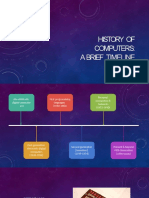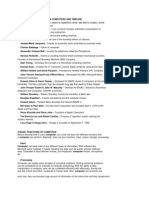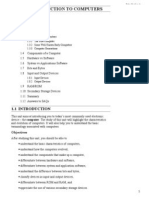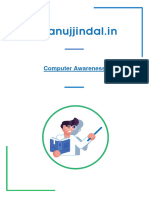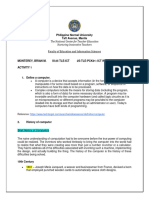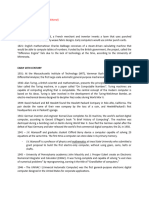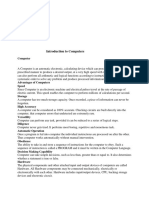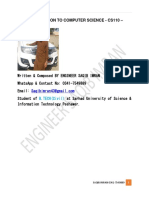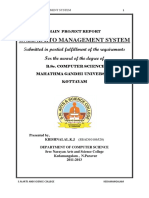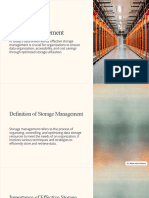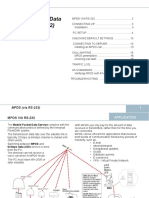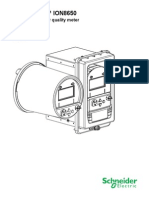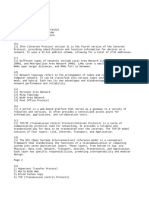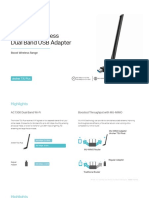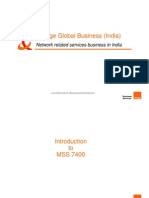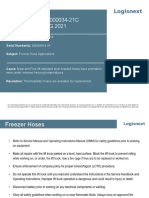Module 1
CHAPTER 1
Introduction to Computers
Computer:
A computer can be defined as an
electronic device that is designed to accept
data, perform the required mathematical and
logical operations at high speed, and output
the result.
• Computers were extremely large in size and often
required an entire room for installation.
• These computers consumed enormous amount of
power and were too expensive to be used for
commercial applications , they were used only for
limited task such as computing trajectories for
astronomical or military applications.
• Nowadays due to smaller size of computers they are
being used in each and every field for commercial
purposes.
Characteristics of computers
1. Speed
Computers can perform millions of operations per second.
The speed of computers is usually given in nanoseconds and
picoseconds, where 1 nanosecond = 1 × 10 −9 seconds and 1
picosecond = 1 × 10 −12 seconds.
2. Accuracy
A computer is a very fast, reliable, and robust electronic device.
It always gives accurate results, provided the correct data and set
of instructions are input to it.
This clearly means that the output generated by a computer
depends on the given instructions
and input data.
If the input data is wrong, then the output will also be erroneous.
In computer terminology, this is known as garbage-in, garbage-
out (GIGO).
Automation
Besides being very fast and accurate, computers are automatable devices that can
perform a task without any user intervention.
The user just needs to assign the task to the computer, after which it automatically
controls different devices attached to it and executes the program instructions.
Diligence
Unlike humans, computers never get tired of a repetitive task.
It can continually work for hours without creating errors. Even if a large number of
executions need to be executed, each and every execution requires the same
duration, and is executed with the same accuracy.
Versatile
Versatility is the quality of being flexible.
Today, computers are used in our daily life in different fields. For example,
they are used as personal computers (PCs) for home use, for business-oriented
tasks, weather forecasting, space exploration, teaching, railways, banking,
medicine, and so on, indicating that computers can perform different tasks
simultaneously.
No IQ
Although the trend today is to make computers intelligent by inducing
artificial intelligence (AI) in them, they still do not have any decision-making
abilities of their own. They need guidance to perform various tasks.
Memory
Similar to humans, computers also have memory, computers also have internal or
primary memory (storage space) as well as external or secondary memory.
While the internal memory of computers is very expensive and limited in size, the
secondary storage is cheaper and of bigger capacity.
The computer stores a large amount of data and programs in the secondary storage
space.
The stored data and programs can be retrieved and used whenever required.
Secondary memory is the key for data storage.
Some examples of secondary devices include floppy disks, optical disks (CDs and
DVDs), hard disk drives (HDDs), and pen drives.
When data and programs have to be used, they are copied from the secondary memory
into the internal memory, often known as random access memory (RAM).
STORED PROGRAM CONCEPT
All digital computers are based on the principle of stored program concept,
which was introduced by Sir John von Neumann in the late 1940s.
The following are the key characteristic features of this concept:
Before any data is processed, instructions are read into memory.
Instructions are stored in the computer’s memory for execution.
Instructions are stored in binary form (using binary numbers—only 0s
and 1s).
Processing starts with the first instruction in the program, which is
copied into a control unit circuit. The control unit executes the
instructions.
Instructions written by the users are performed sequentially until there is
a break in the current flow.
Input/Output and processing operations are performed
simultaneously. While data is being read/written, the central
processing unit (CPU) executes another program in the memory that
is ready for execution
Timeline of Developments
• 300 BC: The abacus was an early aid for mathematical computations and was designed to aid
human’s memory while performing calculations. A skilled abacus operator can add and
subtract with the same speed as that of a person performing the same calculation using a hand
calculator.
• 1822: English mathematician Charles Babbage designed a steam-driven calculating machine
that could compute tables of numbers. Though the project failed as he could not complete the
construction of the engine, it laid the foundation for the first computer.
• 1890: Herman Hollerith, an American inventor, designed a punched card system to calculate
the 1880 census. The system completed the task in three years saving the US government $5
million. Later Herman established a company that we today know as IBM.
• 1936: British mathematician Alan Turing introduced a universal machine called the
Turing machine capable of computing anything that is computable. The central concept
of the modern computer is based on this machine.
• 1941: John Vincent Atanasoff, a Bulgarian-American physicist, and his graduate student,
Clifford Berry, at Iowa State College designed Atanasoff–Berry computer (ABC) that
could solve 29 equations simultaneously. It was the first time a computer could store
information in its main memory.
• 1943–1944: John W. Mauchly and J. Presper Eckert built the Electronic Numerical
Integrator and Calculator (ENIAC), which is considered as the grandfather of digital
computers. It fi lled a 20 × 40 feet room and had 18,000 vacuum tubes.
• 1946: Mauchly and Presper designed the UNIVAC, which was the first commercial computer for
business and government applications.
• 1947: William Shockley, John Bardeen, and Walter Brattain of Bell Laboratories invented the
transistor. Soon vacuum tubes in computers were replaced by transistors.
• 1953: Grace Hopper developed the first computer language COBOL. 1954: The FORTRAN
programming language was developed.
• 1958: Jack Kilby of Texas Instruments and Robert Noyce at Fairchild Semiconductor Corporation
separately invented integrated circuit, which is commonly known as the computer chip.
• 1964: Douglas Engelbart developed a prototype of the modern computer, with a mouse and a
graphical user interface (GUI). This was a remarkable achievement as it shifted computers from a
specialized machine for scientists and mathematicians to general public.
• 1969: Unix operating system was developed at Bell Labs. It was written in the C programming language and
was designed to be portable across multiple platforms.
• 1970: DRAM chip was introduced by Intel.
• 1971: Alan Shugart with his team in IBM invented the fl oppy disk which allowed data to be shared among
computers.
• 1973: Robert Metcalfe, a research member at Xerox, developed Ethernet for connecting multiple computers
and other hardware.
• 1974–1977: Personal computers started becoming popular.
• 1975: Paul Allen and Bill Gates started writing software for the Altair 8800 using the new BASIC language.
On April 4, they both formed their own software company, Microsoft.
• 1976: Steve Jobs and Steve Wozniak started Apple Computers and developed Apple I, the first computer
with a single-circuit board.
• 1977: Apple II was launched that offered colour graphics and incorporated an audio cassette drive for storage.
• 1978: WordStar, a word processor application, was released by MicroPro International.
• 1979: VisiCalc, the f i rst computerized spreadsheet program for personal computers, was unveiled.
• 1981: The fi rst IBM personal computer was introduced that used Microsoft’s MS-DOS operating system. The
term PC was popularized
• 1983: The fi rst laptop was introduced. Moreover, Apple introduced Lisa as the fi rst personal computer with a
GUI with drop-down menus and icons.
• 1985: Microsoft announced Windows as a new operating system.
• 1986: Compaq introduced Deskpro 386 in the market, which was a 32-bit architecture machine that provides
speed comparable to mainframes.
• 1990: Tim Berners-Lee invented World Wide Web with HTML as its publishing language.
• 1993: The Pentium microprocessor introduced the use of graphics and music on PCs.
• 1994: PC games became popular.
• 1996: Sergey Brin and Larry Page developed the Google search engine at Stanford
University.
• 1999: The term Wi-Fi was introduced when users started connecting to the Internet
without wires.
• 2001: Apple introduced Mac OS X operating system, which had protected memory
architecture and pre-emptive multi-tasking, among other benefits. To stay
competitive, Microsoft launched Windows XP.
• 2003: The fi rst 64-bit processor, AMD’s Athlon 64, was brought into the consumer
market.
• 2004: Mozilla released Firefox 1.0 and in the same year Facebook, a social
networking site, was launched.
• 2005: YouTube, a video sharing service, was launched. In the same year, Google
acquired Android, a Linux-based mobile phone operating system.
• 2006: Apple introduced MacBook Pro, its first Intel based, dual-core mobile
computer.
• 2007: Apple released iPhone, which brought many computer functions in the
smartphone.
• 2009: Microsoft launched Windows 7 in which users could pin applications to
the taskbar.
• 2010: Apple launched iPad, which revived the tablet computer segment.
• 2011: Google introduced Chromebook, a laptop that runs on the Google Chrome
operating system.
• 2015: Apple released the Apple Watch. In the same year, Microsoft launched
Windows 10.
First Generation (1942–1955) Hardware Technology
• First generation computers were manufactured using thousands of
vacuum tubes
• A vacuum tube is a device made of fragile glass.
• Electromagnetic relay was used as primary memory and punched cards
were used to store data and instructions.
• Programming was done in machine or assembly language.
• Used for Scientific applications
• Examples ENIAC, EDVAC.
• They were the fastest calculating device of those times
• Computers were too bulky and required a complete room for storage
• Highly unreliable as vacuum tubes emitted a large amount of heat
and burnt frequently
• Required air-conditioned rooms for installation
• Costly
• Difficult to use
• Required constant maintenance because vacuum tubes used
filaments that had limited life time. Therefore, these computers were
prone to frequent hardware failures
Second Generation (1955–1964) Hardware Technology
• Second generation computers were manufactured using transistors
• Transistors were reliable, powerful, cheaper, smaller, and cooler than
vacuum tubes.
• Magnetic core memory was used as primary memory; magnetic tapes and
magnetic disks were used to store data and instructions. These computers
had faster and larger memory than the first generation computers.
• Programming was done in high level programming languages.
• Batch operating system was used.
• Used for Scientific and commercial applications
• Examples: Honeywell 400.
• Faster, smaller, cheaper, reliable, and easier to use than the first generation
computers
• They consumed 1/10th the power consumed by first generation
computers
• Bulky in size and required a complete room for its installation
• Dissipated less heat than first generation computers but still required
air-conditioned rooms
• Costly
• Difficult to use
Third Generation (1964–1975) Hardware Technology
• Third generation computers were manufactured using integrated
chips (ICs)
• ICs consist of several components such as transistors, capacitors,
and resistors on a single chip to avoid wired interconnections
between components.
• Larger magnetic core memory was used as primary memory; larger
capacity magnetic tapes and magnetic disks were used to store data
and instructions.
• Programming was done in high level programming languages such
as FORTRAN, COBOL, Pascal, and BASIC.
• Used for Scientific, commercial, and interactive online applications
• Examples :IBM 360/370.
• Faster, smaller, cheaper, reliable, and easier to use than the
second generation computers
• They consumed less power than second generation computers
• Bulky in size and required a complete room for installation
• Dissipated less heat than second generation computers but
still required air-conditioned rooms
• Costly
• Easier to use and upgrade
Fourth Generation (1975-1989) Hardware were Technology
• Fourth generation computers manufactured using ICs with LSI (Large
Scale Integrated) and later with VLSI technology (Very Large Scale
Integration),
• Microcomputers came into existence.
• Use of personal computers became widespread.
• High speed computer networks in the form of LANs, WANs, and MANs
started growing,
• Semiconductor memory was used as primary memory, large capacity
magnetic disks were used as built- secondary memory.
• Magnetic tapes and floppy disks were used as portable storage devices
• Programming was done in high level programming language such as C
and C++ .
• Graphical User Interface (GUI) based operating system (ex: Windows)
was introduced.
• It had icons and menus among other features to allow computers
to be used as a general purpose machine by all users.
• UNIX was also introduced as an open source operating system.
• Apple Mac OS and MS DOS were also released during this
period.
• All these operating systems had multi-processing and multi-
programming capabilities, Used for Scientific, commercial.
interactive online, and network applications
• Examples: 1BM PC. Apple Il.
• Highlights Faster, smaller, cheaper, powerful, reliable, and easier
to use than the previous generation computers
Fifth Generation (1989-Present) Hardware Technology
• Fifth generation computers are manufactured using ICs with ULSI (Ultra Large
Scale technology.
• The use of Internet became widespread and very powerful mainframes,
desktops, portable laptops, and Smartphone's are being used commonly
• Supercomputers use parallel processing techniques,
• Semiconductor memory is used as primary memory: large capacity magnetic
disks are used as built-in secondary memory.
• Magnetic tapes and floppy disks were used as portable storage devices, which
have now been replaced by optical disks and USB flash drives.
• Programming is done in high-level programming languages such as Java,
Python, and C# .
• These operating systems are more powerful and user friendly than the ones
available in the previous generations.
• Used for Scientific, commercial, interactive online, multimedia
(graphics, audio, video), and network applications
• Examples: 1BM_ notebooks, Pentium PCs.
• Faster, smaller, cheaper, powerful, reliable, and easier to use
than the previous generation computers
• Speed of microprocessors and the size of memory are growing
rapidly
• They consume less power than computers of prior generations
• Air-conditioned rooms required for mainframes and
supercomputers but not for microprocessors






